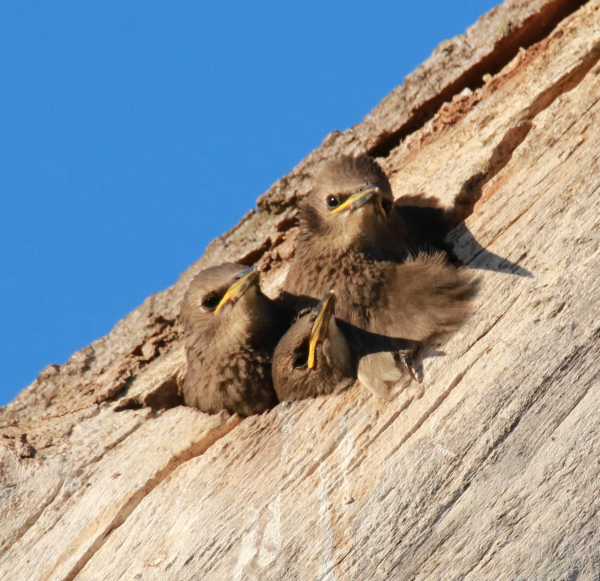
During the post-fledging period, when young birds like this robin leave the nest they quickly learn to fly, search for food, and flee potential danger.

These nestlings are about to leave their cavity nest to begin their post-fledging period when the adults will feed and protect them while they learn to fly and find food for themselves. Can you identify these nestlings? (You can see the answer in the third photo in the Editor Afield article in this issue.)
|
Although the nesting season is just starting for many birds, some early-nesting birds have completed successful nesting attempts. You may have already seen some new fledglings, and others are ready to leave their nests. We all enjoy seeing new fledglings such as robins, cardinals, bluebirds, screech owls, and other altricial fledglings after they leave the nest, along with precocial hatchlings like Killdeer, ducklings, quail, and others that leave the nest within a few hours of hatching. Witnessing the successes of the nesting season is a wonderful experience and a fulfilling part of the enjoyment of providing nesting habitat, along with foods and fresh water.
At the same time, it’s important to recognize that these young birds need no human “help.” Please encourage everyone, including children, not to disturb young birds that are appearing in our yards, neighborhoods, local parks, and rural areas. When young birds leave the nest, it is an especially hazardous time for them, known as the “post-fledging period,” when new fledglings that have left the nest continue to be cared for and fed by adults.
The fledglings are just learning what to eat, where to find food, and what constitutes danger – not to mention that they are learning to fly! Young birds are actually the most vulnerable after leaving the nest than at other time in their life.
When you find a young bird, please don’t disturb it. Leave it where it is; one or both of its attentive parents are nearby and will soon be bringing food to the fledgling. This fledgling learning period is paramount to the survival of young birds. So have faith, the little bird does not need your assistance or rescue. If it can’t fly yet, never fear; it will be flying quite well in a few hours, or in a day or two. If you watch, it’s amazing to see how quickly young songbirds learn to fly. In the meantime, it will follow a parent to beg for food and learn how and where to find food in the process.
In fact, some young birds leave the nest a few weeks before they can fly – young owls for instance. Nestling owls usually leave the nest days or weeks before they can fly, perching near the nest and walking on adjacent branches. These birds are referred to as “branchers,” and this behavior may continue for weeks before they make their first simple attempts at flying. Even if young birds get blown out of their nest, the adults continue to protect and feed them through the pre-fledging period.
A nest is not a safety net – it’s easy for predators to wreck a nest and nesting attempt at the egg or nestling stage. That happens, and that’s the way nature works, and it’s how population dynamics works. Not every nesting attempt is successful, and not every nestling or hatchling survives. In fact, if all nesting attempts were successful and all nestlings survived, we’d be overrun by birds each summer. Overall, nature takes it course, and we should remain observers and not make judgements without having all the information about the status of fledglings and hatchlings we see.
The worst thing that can happen is for a person to intervene in a fledgling’s development - it can be the equivalent of a predator eliminating a bird from the population. The post-fledging period is a critical time during the nesting period, as young birds leave the nest, learn about finding food on their own, and learn to fly – all while one or both adults protect them and provide supplemental feeding. There may be some learning involved in the process too, although many birds possess an innate (in-born) behaviors that allow them to progress through this period with a minimum of oversight from an adult or pair.
The post-fledging period may last a few days or weeks among smaller birds including some songbirds; but it may last for months in some larger birds such as owls, hawks, eagles, ducks, geese, cranes, and others. Have faith and let nature take its course;, let birds do what they do. Enjoy observing young birds during the post-fledging period, which is an especially interesting time in our birding year, as a variety of nesting birds continue to protect, feed, and teach their fledglings all around you.
Share your backyard birding experiences and photos at editorstbw2@gmail.com